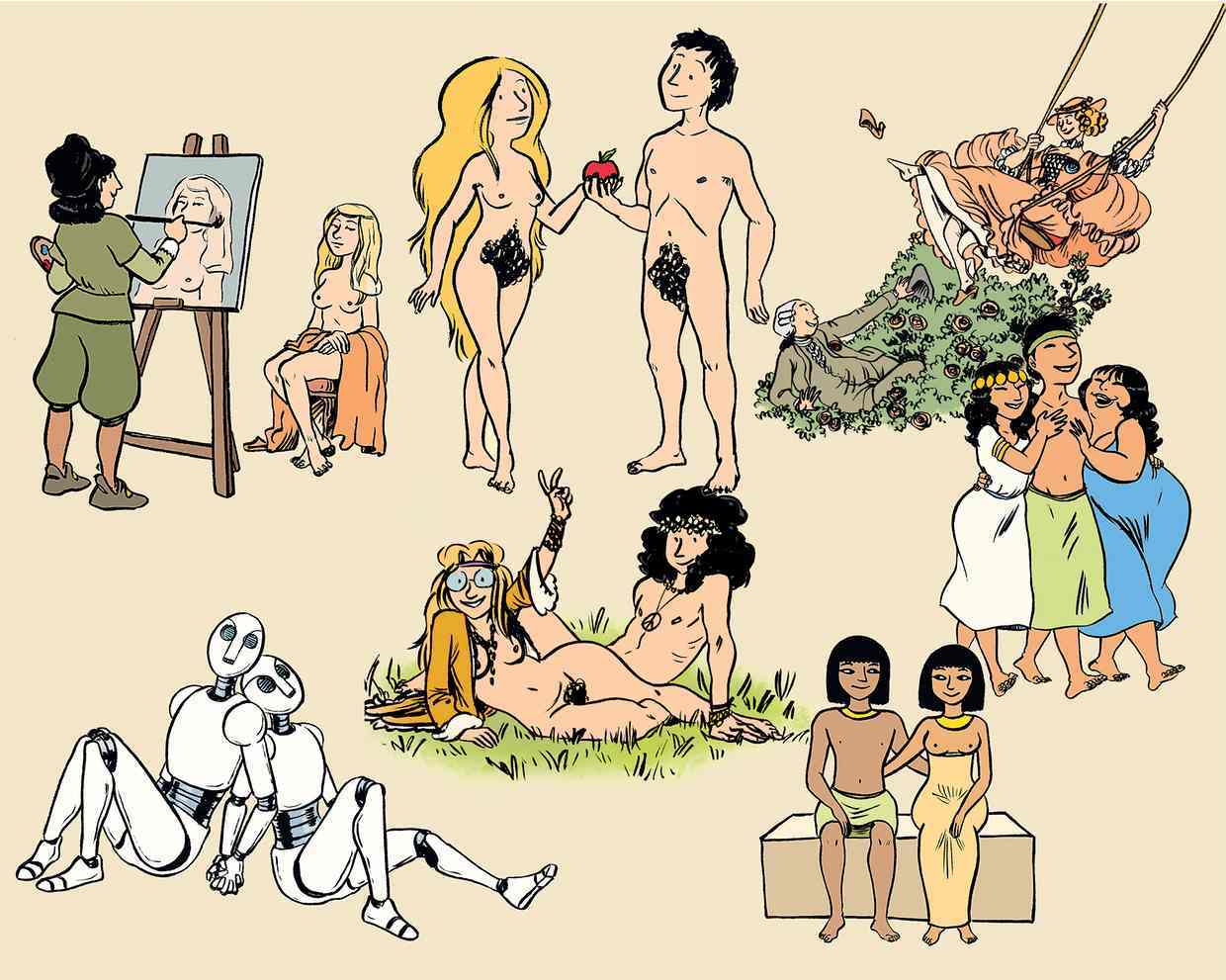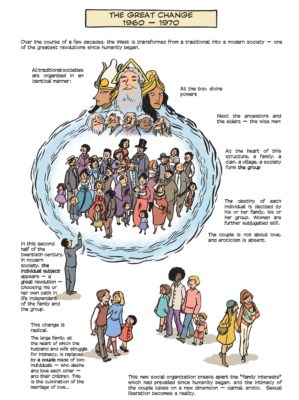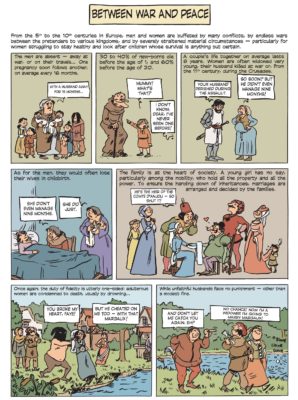
02 Nov A graphic history of sex: ‘There is no gene that drives sexuality. All sexuality is learned’
Changes in sexuality over time have made the modern family what it is. What next? Homa Khaleeli asks the authors of a groundbreaking graphic guide, The Story of Sex
Philip Larkin famously announced that sexual intercourse began in 1963 (“Between the end of the ‘Chatterley’ ban / And the Beatles’ first LP”). Being French, and a psychiatrist to boot, Philippe Brenot takes a rather longer view. In his latest book, The Story of Sex, a bestseller in France, he runs an anthropological eye over the sexual mores of human societies from prehistoric times to today. Yet Brenot believes that the sexual revolution did spark a dramatic change, creating the modern couple, which is the basis of our families today. Now, however, he thinks this partnership of equals is under assault from all sides.
The academic, who has the wonderful title of director of sexology at Paris Descartes University, has spent his life studying sexuality. The Story of Sex is an irreverent, graphic novel (in both senses), filled with fascinating – if alarming – history. Cleopatra used a vibrator filled with bees; the word “trousers” was considered to be positively pornographic in Victorian England. Illustrator Laetitia Coryn’s extremely cheeky, but never sordid, pictures liven up the page and keep the narrative zipping along. The book was a real collaboration, says Coryn, who says it was made easier by Brenot’s firm ideas – and the fact he liked her jokes.
The illustrator admits she hesitated slightly over collaborating on the book. “I told my publisher we have to be careful with the drawings and with the jokes – we have to be sensitive,” she says, because she wanted the book to have as wide an audience as possible. “I didn’t put any porn in it!” As a reader, however, the frankness of the pictures still shocked me (you, er, might not want to whip out the book on public transport or in the office).
Talking to Brenot over the phone (through charmingly accented English that becomes somewhat eccentric as he struggles with the complexities of his ideas) it’s impossible to escape the psychiatrist’s anxiety about our attitudes to love and intimacy today. We have never been freer to define our own relationships, and follow our own pleasure, he says, but despite this we are far from satisfied; and the modern couple is looking dangerously fragile.
“It’s incredible the difficulties couples have,” Brenot declares, in a tone that makes me imagine he is throwing his hands in the air in despair. Of the couples he sees in therapy, he says, “there is nothing wrong with them psychologically, but still they cannot communicate quietly, live calmly and have sexual fulfilment”.
While we think of lovers as a timeless relationship model, it has been the family that has been paramount in society for most of history, the 68-year-old says. “The couple used to get together for the sake of the family,” he explains. And the idea of equality in long-term pairings is even more recent, with “traditional” marriages putting men firmly in charge of their spouses.
“Love marriages have only been widespread for a century or so, and homosexuality was condemned until very recently,” Brenot notes.
“Since the 1970s, we have begun to invent modern couples with respect for each other and equality between the sexes,” he says. “This only came about after ‘marriage’ as a concept began dying out. Not because people stopped getting married, but because marriage stopped being seen as a sacred union – couples instead started developing on their own terms.”
Yet the rise in divorces since the 1970s and breakups of long-term relationships shows that the modern couple is not surviving, Brenot argues. In part, he says, this is because we are demanding more than ever before.
“It is difficult to live intimately, because we want perfect love and perfect sex and that is very difficult in a long-term relationship. We want a lot more than a reliable person to raise kids with.”
The solution, he says, is for us all to learn more about sex – which is where his book comes in. “It’s not possible to understand our intimate sex lives without looking at centuries of history, and even the origins of human life,” he says. “We understand what we live today if we understand from where we came.”
For instance, he says, if we look at the way relationships were formed in early human societies we can see echoes of our own problems. “We came from primates, but in chimp society there are never couples or families. There are lone males and females with children.” It was only as our brains evolved and emotions developed – including love – that monogamous relationships set in. For the first time (“somewhere between 1 million BC and 100,000BC”), it was possible to know the paternity of a child.
While the beginning of family life may sound like a wonderful moment, Brenot argues that it was also the start of women’s subjugation, with men taking possession of their female partner and offspring – which traditional marriage legalised. “Paternity is the beginning of male domination,” says Brenot simply. “The day that happened, men took possession of women.”
In the animal kingdom, Brenot argues, there is none of the domination of female partners that has been a hallmark of human societies through history, nor is there domestic violence. Instead, among animals “males fight against other males and females fight with other females,” he says.
“Violence between men and women is only in humans – because of marriage, which puts men above women.”
During antiquity, meanwhile, a woman’s role was to provide a child – and female sexual pleasure was dismissed. But this role was also a dangerous one. “There were so many impediments to female pleasure. In the 18th and 19th centuries, one in six pregnant women died in childbirth. Then there were the infections and sexual violence.”
For men, of course, things were different. “Men have always done what they wanted,” says Brenot.
Even for men, sex for pleasure was something that happened “outside the home – for instance with prostitutes. Women were seen either to provide offspring or pleasure.” In ancient Rome, these rules were so strictly upheld that women could take their husbands to court for ejaculating anywhere but inside her body during intercourse, “because sex within marriage was for procreation, and the wife’s role was to receive sperm”.
Even during periods that today we think of as being golden ages for same-sex relationships, such pleasures were “reserved for the elite” – and the reality was often less accepting than we think. In ancient Greece, for instance, it was only the man who was “receiving” who was not stigmatised in a pairing. Similarly for the libertines in the 18th century, “there was a fluid sexuality, but it was also the top end of society – the intelligentsia and aristocracy. Throughout the centuries and the world’s rural populations, to be gay – or for women to have control of their own sexuality – has always been frowned upon.”
Today too, Brenot argues, while much has been written about more people exploring fluid sexualities, entering polyamorous relationships and breaking down gender norms, “we shouldn’t make the mistake of thinking that this is trickling down to all sections of society”. And he warns too about a backlash from “new moralists” who oppose gay marriage, and will, no doubt, do the same for trans rights and alternative relationships as they gain more legal rights. Coryn says this is one of the reasons she enjoyed creating the book. “In France, people who don’t want gay people to be married, is a huge phenomenon. It’s awful. We say in the book this is a misunderstanding of sexuality; homosexuality is normal. I hope this is one topic on which people will change their mind in reading the book.”
For heterosexual couples, relationships began to look up about the time of the Renaissance and Enlightenment. Up until this period, “men were having fun outside the home – hunting animals or chasing women. While women were always at home,” says Brenot. But the new spirit of education and the pursuit of knowledge changed this. Finally, says Brenot, men and women could be friends and even have platonic love.
Yet it took contraception for men and women to gain a semblance of equality. Previously “women were immobilised by marriage. They can’t get out of it, they don’t have the possibility of working or being free. The story of sex is, first of all, the story of marriage and the difficulties [it creates] for women.”
To start combating the problems that these historical inequalities have left us with, the psychiatrist insists, we need better sexual education, and one that starts at an early age. “People think sexuality is just an instinct,” he says, “that it is natural like eating and drinking. No. There is no gene that drives sexuality. All sexuality is learned.”
Because of this, says Brenot, the models for our sexuality are very important. Today, talking about sex is still taboo, and the dissemination of pornography has filled the void. “People say pornography changes adolescent life. But it changes everyone’s sexuality,” he says. “We have sex differently now; we try to imitate what we see [on our screens]. People feel bad and say, ‘I can’t do what they do.’”
To displace this dangerous model, “sexual education should teach the rules that should govern relationships; it should teach us about communication, about consent and respect. This is not natural [to us]. We have to learn this.”
Coryn says that while the Story of Sex is not a sexual education manual, “we wanted it to be uninhibited”, to make talking about sex seem as natural as it should be.
“From the time children are little girls and boys, we have to teach them that everyone should be respected and to start accepting difference,” says Brenot. But, he says, while men and women are equal, that does not mean that they are the same. Railing against the teaching of “gender studies” departments, he says that a refusal to admit this difference is allowing gender inequality to become entrenched.
“They say, ‘Don’t speak of differences – a man is the same as a woman. Society is guilty of making differences, but underneath we are the same.’”
Unpicking these ideas, he says, is the only way to combat our most pressing problems. For example, “physical strength is different from a very young age. So [children] need to understand boys are stronger and take that into account – because that is the start of domestic violence, which is a real problem.”
If we leave this teaching too late, he says, the battle is already lost: “In children’s fairy stories it is the boy who seduces the girl, so there is power play early on.” Then there is the fact men have always been free to have multiple partners throughout history, because men don’t get pregnant. It is only by introducing the idea early on that “contraception is a joint responsibility” that we can challenge this.
Today’s modern couple, he points out, faces new challenges from the rise in options for dating to “new forms of relationship,” says Brenot. Yet Coryn stresses, as does Brenot, that there has never been a better time for people to live in terms of sexuality. Yet one thing has not changed, says Brenot – everyone still wants to find somebody to love. “People are afraid to be alone at the end of their life. They are afraid not to find the perfect person to live with. It is a difficult problem for everyone today.
“We have to learn how to live together anew.”




